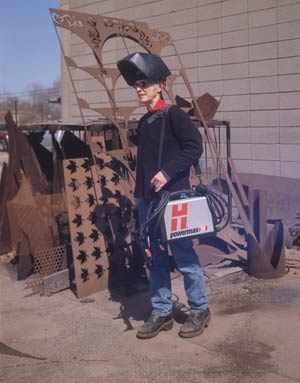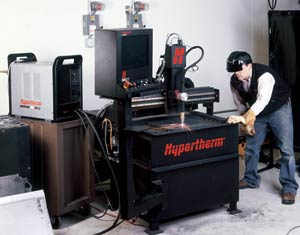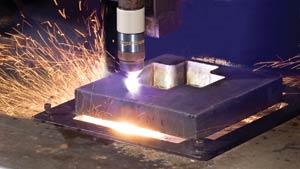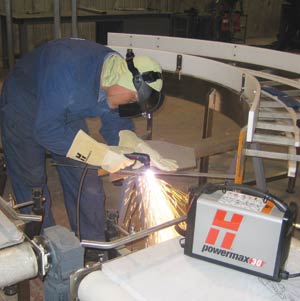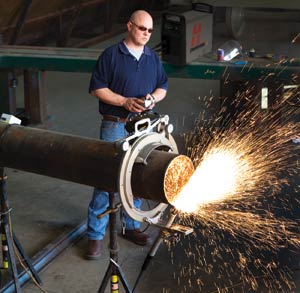PLASMA CUTTING: VERSATILE FOR BOTH MANUAL AND MECHANIZED CUTTING APPLICATIONS
The cut quality, consumable life and reliability of the plasma cutters used in the past is just that – a memory of the past! Let’s evaluate the different categories of new plasma cutting systems to show how they can benefit those fabricators of steel parts that have traditionally used traditionally oxy-fuel cutting.
Posted: July 18, 2011
Plasma systems have always been known for their productivity – even the earliest systems could cut steel much faster than oxy-fuel. However, new plasma systems – from the high-end industrial classes to the lower-priced portable air plasma systems – are now earning a reputation as the most versatile metal cutting process.
In light of the recent industry-wide shortage of acetylene used for a variety of cutting and welding applications, plasma machinery manufacturers have noticed a rather dramatic increase in demand for both hand-held and mechanized plasma cutting equipment that is destined to fill the void created by the shortage . . . a shift that is easing fabricators’ concerns that they will not be able to effectively cut steel as the economy continues its upswing.
On closer examination, many of these fabricators are quickly discovering that the plasma systems now available to compete with both hand-held and mechanized oxy-fuel torches are of superior technology as compared to plasma equipment of a decade ago. In fact, in many cases they can actually provide better cut quality, much higher productivity and lower operating cost, as well as a higher level of automation as compared to their oxy-fuel systems for steel cutting applications.
A few of the major manufacturers of plasma cutting machinery have invested large amounts of engineering resources into improving this 50-year-old technology, with the direct result being a wide range of available systems designed to fit three basic categories of cutting requirements:
- Portable and low capital cost Air Plasma systems,
- Conventional Industrial Multigas Plasma Systems,
- and High Definition Class Industrial Plasma systems.
Each of the these categories of plasma systems have excellent potential to replace and improve shop floor or field oxy-fuel cutting capabilities, not just because acetylene has become scarce and more costly, but because the technology and performance of these systems have improved considerably.
Many fabricators are discovering that the cut quality, consumable life and the reliability of plasma cutters that they may have used in the past is just that – a memory of the past! To better understand this, let’s take a quick look at the different categories of new plasma cutting systems to see how they can benefit those fabricators of steel parts that have traditionally used oxy-fuel cutting.
AIR PLASMA SYSTEMS
This is the lowest-cost category of plasma cutting machinery from a capital equipment perspective, but it represents the market with perhaps the widest range of choices. Many of these versatile systems can be used for portable field cutting with either hand-held or mechanized torches, or can be utilized on the shop floor for hand cutting and arc gouging. They can also be used with a variety of mechanized cutting equipment that includes, but is not limited to, circle cutting attachments, Track Burners, Tube and Pipe cutters and a wide variety of robotic applications, as well as CNC X-Y cutting tables for processing flat plate.
Hand Cutting
If your memory of hand plasma cutting is of bulky, heavy equipment that required high input power, had short consumable parts life, was marginally reliable and limited in applications, then perhaps this use for plasma systems should be revisited.
The newest high-end inverter-based portable air plasma systems are available in power levels from 30 amps to 100 amps. They can be easily lifted and moved by one worker, they use relatively low input power levels, and they have quick disconnect torches for easy field changeout from a mechanized torch to a couple of different styles of hand-held torches.
Hold one of these new air plasma torches in your hand, lay the torch directly on the plate – use a template or straightedge as a guide if desired – pull the trigger and start cutting. The operator does not have to learn about setting the gas pressures or pre-heat because the air flow settings on the newest plasma systems are fully automated and matched to the consumables and torch being used. New plasma torches will start easily on coated, rusty or dirty steel and consumable life can be literally 10 times the consumable life of air plasmas from a decade ago.
For dismantling or removing welds for field repairs, simply insert a gouging nozzle, flip a selector switch into the gouge mode, spend a few minutes mastering the best technique, and you will be amazed at the gouging capabilities of the newest air plasma systems as compared to oxy-fuel and carbon arc. There are even special 15 deg torches designed to keep the operator a safe distance back when gouging or doing demolition/dismantling work. And, of course, don’t forget that plasma increases cutting versatility in the field on aluminum, stainless and other non-ferrous materials.
Mechanized Cutting With An Air Plasma
This area is perhaps one of the fastest growing segments for low-cost air plasma systems. Due to advancements in motion control technology that led to the development of low-cost entry-level CNC cutting machines, a whole new market of low capital cost, light duty, yet very productive and accurate cutting machines has materialized.
Couple these machines and their included software with a good quality air plasma system with a machine torch and you can have a fully functional 4 x 4 or 5 x 10 CNC plasma system in your shop for under $15,000 – a price unheard of just a few years ago for a machine that can be this accurate and productive. Keep in mind that these entry level (or low cost) machines will not replace the same size machines that are designed for years of high duty cycle industrial use.
Industrial-type systems generally involve much heavier construction, use gearboxes and integrate mechanical components, drives, CNC controls and plasma systems that were designed to cut three shifts a day for many years at high duty cycles. The breakthroughs in technology, however, have now allowed the small shop or maintenance division of many companies the luxury of affording their own CNC plasma systems.
High Definition Class Industrial Plasma Systems
These systems, generally available in the 130 amp to 800 amp range, are designed to provide much faster cut speeds, better cut quality, and thicker cut capacity, up to 3 in on carbon steel and 6¼ in on stainless and aluminum, all at a much lower operating cost (based on faster speeds, superior consumable parts life, as well as less secondary operations due to better cut quality).
The industrial mechanized plasma systems are not available with hand torches. They are designed to be the high productivity answer for cutting carbon steel in the gauge to 2 in thickness range at speeds faster than – with better cut quality – than oxy-fuel.
It is true that the plasma is considerably more expensive to install on a CNC machine as compared to oxy-fuel. However, the low operating cost of a plasma cutting system can generally offset the additional capital costs in as little as six months in a typical two-shift per day fabricating shop. Modern progressive shops are using 400 amp oxygen-based high definition plasma systems to replace oxy-fuel cutting for up to 2 in plate in many applications.
With a skilled operator a typical oxy-fuel torch can preheat and pierce 2 in steel in about 12 to 15 seconds, and can cut that steel at around 12 ipm to 14 ipm. The plasma comparison (at 400 amps) is a 3.5 second pierce time and cutting at 30 ipm. And since the process is highly automated, operator skill is not required to dial in the cut quality of the plasma!
As the steel gets thinner, the plasma speed advantage gets exponentially better . . . ½ in steel at 185 ipm. Further enhancements to the plasma process that were important in improving the comparison between plasma, oxy-fuel, and laser are the new true hole cutting technologies (see “New Plasma Cutting Technology Takes Care Of The ‘Hole’ Issue,” Slice of Advice, 1Q 2010), as well as dramatically improved cut-to-cut cycle times. For example, the process of using CAM software to coordinate all major components of the cutting machine for a speedier, easier process.
The bottom line is this: When considering the latest technologies, perhaps it is time to take a new, fresh look on the shop floor at the use of oxy-fuel equipment. Oxy-fuel applications represent a prime area where some new systems could generate dramatic productivity improvements. With the right equipment, lower operating costs and added cutting machine versatility will go hand-in-hand with the increased productivity – exactly what fabricators need in this new era of production floor efficiency.





